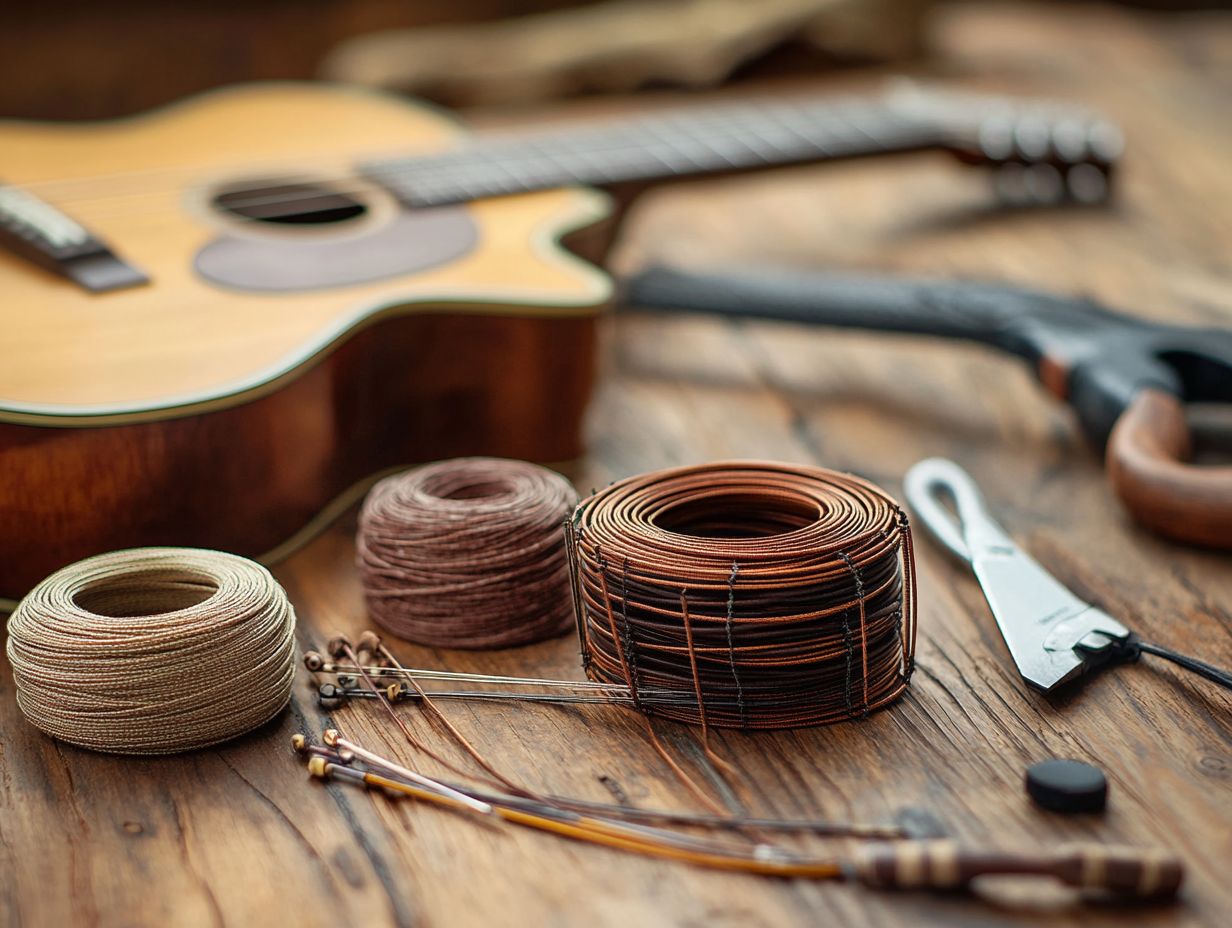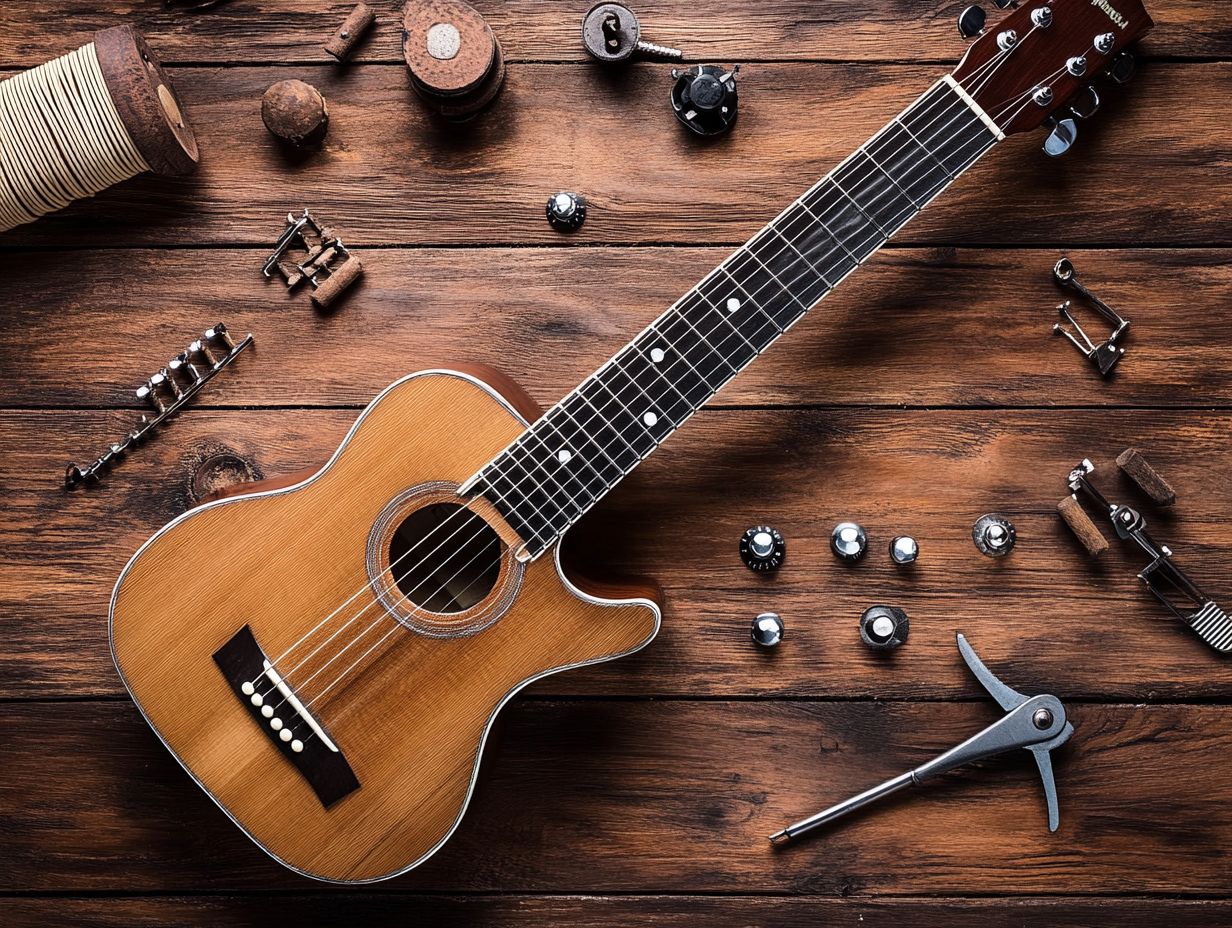Selecting the right guitar strings can significantly enhance the playing experience for beginners. With numerous options available, it is essential to understand the different materials, gauges, and coatings of guitar strings. This article explores the best guitar strings for beginners and offers insights into top string brands and their features. Additionally, it provides important guidelines for purchasing and maintaining guitar strings to ensure your instrument remains in great condition as you embark on your musical journey. This comprehensive buying guide will help you navigate the choices and make informed decisions about string types, sound quality, and playability.
Understanding the Basics

Understanding the basics of guitar strings is essential for beginner guitarists who wish to enhance their playing experience on both acoustic and electric guitars. This includes familiarizing oneself with the fretboard and the impact of string materials on tone and durability.
Different types of guitar strings, such as nylon strings and steel strings, provide varied tonal qualities and playability, making them suited for different music genres.
As you embark on your journey to learn the guitar, grasping these fundamentals will not only improve your sound quality but also support your overall development as a musician. Understanding the nuances of string thickness, or gauge, and how it affects tension and playability is crucial.
By focusing on string selection, gauge, and tension, you will be better equipped to make informed decisions that align with your personal sound preferences.
Factors to Consider When Choosing Guitar Strings
Choosing the best guitar strings for your instrument depends on several factors, including string material, gauge, tension, and sound quality. Brands like D’Addario, Ernie Ball, and Fender offer a variety of strings designed to cater to different playing styles and music genres. Factors such as string winding and tone also play a significant role in the overall performance of the strings. Understanding these key components can enhance your guitar’s performance and increase your enjoyment during practice and performance.
String Material: The material used to make guitar strings significantly affects their sound and feel. Nylon strings are commonly used for classical guitar playing, where fingerpicking is prevalent. Steel strings, on the other hand, are primarily used with acoustic folk guitars, which often involve substantial strumming. Electric guitars predominantly use steel or nickel strings, as the amplifier creates a distinct sound dynamic.
Gauge: The thickness of a guitar string is referred to as its gauge, measured in mils or thousandths of an inch. Different types of guitar strings come in varying gauges, and selecting the appropriate gauge can influence the sound and tone of the instrument. Thicker strings typically produce a louder, brighter tone, while thinner strings yield a softer sound. Thicker strings are also more durable and can withstand greater tension, whereas thinner strings are easier to press down and bend, making them ideal for beginners. A standard set of medium gauge acoustic guitar strings generally ranges from .012 (high E string) to .054 (low E string). In contrast, electric guitar strings are slightly thinner, with a standard medium gauge set ranging from .009 to .046. Classical guitar strings come in various tensions, including extra-light (.028-.043), medium (.029-.045), and hard tension (.030-.046).
String Tension: String tension refers to the amount of force the strings exert on the guitar’s body. Guitars with higher tension typically use thicker strings, and the overall pressure from the strings is adjusted according to the wood types to achieve optimal sound quality. Tension influences playability and the acoustic quality of the sound produced. Higher tension strings can generate greater volume and a brighter tone but require more finger strength, while lower tension strings offer a softer sound and are easier to play.
String Quality: The quality of guitar strings is determined by the brand and type you choose. Well-known brands include D’Addario, Ernie Ball, Martin, Fender, La Bella, GHS, Rotosound, Cleartone, and Dunlop, among others. Each brand offers different types of strings. Generally, acoustic guitars tend to produce warmer and mellower tones compared to electric guitars, but the sound quality is primarily influenced by the type of strings used, as well as the brand and material of the guitar itself.
Material

The material of guitar strings significantly influences their tonal qualities and longevity. Nylon strings produce a warm sound, while steel strings offer a brighter tone.
Coated strings, crafted from materials that enhance durability, provide musicians with a longer string life and a more consistent tone over time. Understanding the material options for guitar strings can help beginner guitarists make informed choices that align with their desired sound characteristics and playing styles. Beginner-friendly brands often provide detailed descriptions and user experiences to guide new players.
For instance, nylon strings create a softer, warmer tone and are most commonly used by classical guitarists, whereas the brighter and more projecting sound of steel strings makes them ideal for folk and rock guitarists.
Tension is another important factor; lighter gauge strings are easier to play but may lack some tonal qualities, while heavier strings, which provide more volume and sustain, require greater finger strength—something that can be challenging for beginners. Choosing the right tension and gauge can enhance playability ease and reduce the learning curve.
Guitar string manufacturers like D’Addario and Ernie Ball offer specific strings for different genres, demonstrating how string material and design can affect a guitarist’s overall experience.
Gauge
Guitar string gauge, or thickness, is one of the most important characteristics of a string set. The gauge affects the tension of the strings, which subsequently influences action, playability, intonation, and tone.
Generally, thinner strings have lower tension, making them easier to play, which is particularly beneficial for beginner guitarists. In contrast, thicker strings have higher tension and produce a fuller sound. By understanding how gauge affects string tension, you can strike a balance between ease of play and the performance you need as you develop your playing techniques.
For example, strummers may prefer lighter gauges, as they are easier on the fingers and hands, reducing fretting pressure. This is especially advantageous for strummers in folk and pop styles, who often need to play continuously for long periods. On the other hand, fingerstyle players typically favor medium gauges, which offer a more responsive feel when plucked or strummed.
A common mistake among beginners is choosing strings that are too thick, which can lead to frustration and decreased enjoyment while playing. When unsure about which gauge to select, players often wonder what is best for them. Experimenting with different gauges while considering their preferred genre can help players make more informed decisions.
Coating

Coated strings are designed to enhance longevity and sound quality by protecting against dirt and corrosion, making them an ideal choice for guitarists seeking durable strings. These innovations in guitar strings are particularly beneficial in varying environmental factors like humidity. These coatings can also modify the feel of the strings, allowing players to adapt to their individual preferences and playing styles. Understanding the advantages and disadvantages of coated strings helps beginner guitarists choose options that align with their maintenance habits and desired tonal qualities.
The most common types of coatings are polymer and nylon, each with distinct benefits. Polymer-coated strings typically produce a bright sound and extend the strings’ lifespan, while nylon-coated strings offer a softer and warmer tone, making them more suitable for classical musicians.
- Other coating types include coil and synthetic coatings, each with its own advantages.
- Coil-coated strings are known for their durability and resistance to corrosion and dirt.
- Synthetic strings are usually more affordable and allow for easy customization and maintenance.
Uncoated strings, on the other hand, tend to deliver a more resonant sound, which some musicians prefer. To maintain string quality, wiping them down after each use is the best practice, as it reduces build-up and enhances their performance and longevity.
Recommended Guitar Strings for Beginners
The best guitar strings for beginners are those that are easy to play, produce good sound quality, and are reasonably priced. Brands such as D’Addario, Ernie Ball, and Fender are among the top choices for beginner guitarists, offering a variety of options suitable for their needs. For those considering their equipment budget, these brands provide a range of price points to accommodate different financial constraints. Cost-effectiveness and durability are crucial factors when selecting strings for practice and learning.
User reviews frequently highlight strings that provide a balanced tonal range and excellent playability, helping new guitar players learn without excessive frustration.
Top Brands and Their Features

Some of the best guitar string brands include D’Addario, Ernie Ball, and Fender, each offering a variety of high-quality options tailored to different playing styles and preferences.
D’Addario provides a wider range of string types, with phosphor bronze acoustic strings delivering warmth and projection, while nickel wound electric strings produce bright and clear tones. Their strings are known for their tuning stability and sound projection. Many professional musicians favor D’Addario strings for their consistent quality and durability.
Ernie Ball’s strings, particularly the Slinky series, are renowned for their flexibility and smooth playability, making them a favorite among guitarists who seek a faster, more responsive feel. The brand also receives positive reviews for its diverse gauge options, enabling players to find their ideal balance.
Fender strings are not only relatively inexpensive but also boast high tensile strength, which contributes to their long-lasting performance—a valuable feature for beginners who are still honing their technique. User reviews often highlight their reliability and resonance.
By comparing these brands based on user experiences and their distinctive strengths, beginners can make more informed choices that align with their playing style. Feedback from instructors and community feedback can also provide valuable insights for selecting the right strings.
Tips for Buying and Maintaining Guitar Strings
Proper maintenance and timely replacement of guitar strings, such as nylon strings and steel strings, can significantly enhance their performance and lifespan. Paying attention to string life and string care helps ensure durability and longevity.
Regular maintenance practices, such as cleaning and careful handling, can improve tuning stability, prevent fret buzz, and extend the longevity of the strings. It’s important to consider string compatibility with your guitar type for optimal maintenance.
Additionally, expert advice on recognizing when to replace your strings can help beginner guitarists avoid common mistakes that may diminish sound quality throughout their playing journey. Maintaining good string care and understanding string elasticity are key aspects for all levels of players.
Where to Buy and How to Care for Your Strings
When purchasing guitar strings, musicians have several options, including music shops, local stores, and online retailers, often with various discounts and promotions available. Consulting a buying guide can help in making informed decisions. Each method of purchasing offers distinct advantages and disadvantages, including considering brand reputation and user experience.
In-store shopping allows musicians to feel and evaluate the strings before making a purchase, while online shopping provides access to a broader selection of brands and types of strings at competitive prices. Online shopping also offers community feedback and reviews. However, both options come with drawbacks, such as potential shipping delays for online orders or limited stock at local stores.
The packaging of guitar strings is crucial for maintaining quality, as proper sealing can prevent corrosion and preserve the strings’ vibrant sound. Proper string winding and understanding string age are essential aspects of string care. Additionally, musicians can benefit from seeking out online tutorials and learning resources that focus on string maintenance and replacement techniques, which can help them care for their instruments effectively without the need for professional assistance.
Choosing the Right Strings for Your Needs
Choosing the right guitar strings is crucial because it allows you to select options that best suit your needs, preferences, and playing style. The right strings will provide the versatility and comfort you desire. Exploring string types, such as acoustic guitar or electric guitar strings, and considering string thickness can significantly affect playability. The sound qualities that matter to you and the type of music you play will help you determine which strings to use.
For instance, if you seek a brighter or warmer tone, you may need to experiment with different types of strings and gauges, even if it means stepping outside your usual preferences and past experiences. Understanding the impact of string materials, such as nickel or bronze, can also help you achieve the desired tone and sound characteristics.
Trying various combinations of string materials, coatings, gauges, and playing techniques can help you identify the best options for your instrument and playing style, ultimately making your experience more enjoyable. Considering factors such as tension, resonance, and string sustain will contribute to finding the best guitar strings for your needs.
For example, using lighter gauge strings can reduce the pressure needed while playing, which is particularly beneficial for beginners as their fingers build up calluses. Conversely, heavier gauge strings can produce a fuller sound, which some advanced players may prefer. The choice of gauge can also affect playability ease and string elasticity.
Additionally, the choice of materials—such as nickel, bronze, or coated strings—significantly affects the brightness and warmth of the instrument’s sound. Considering string technology and innovations in guitar strings can further enhance your playing experience and sound projection.



